BSBMGT616 Develop and Implement Strategic Plans Assessment
VerifiedAdded on 2020/03/02
|9
|1568
|38
Homework Assignment
AI Summary
This assessment, completed by a student, addresses key aspects of strategic planning and its implementation. It begins by outlining the requirements of relevant legislation and regulations, including Work Health and Safety, environmental regulations, industrial relations, anti-discrimination, and privacy laws, emphasizing their impact on strategic plans. The assessment then identifies risks associated with strategic planning, such as environmental uncertainties, lack of staff involvement, and funding limitations. It further explores risk management strategies, including defining business objectives, establishing key performance indicators, and continuous monitoring. The PEST (political, economic, social, and technological) and SWOT (strengths, weaknesses, opportunities, and threats) analyses are described as crucial tools for evaluating the business environment. The assignment also identifies internal and external sources of information, such as sales data, consumer preferences, and market surveys. Finally, it outlines techniques for developing organizational values, including defining core values, aligning actions with vision, and embedding values through performance measures. The assessment concludes with a reference list and an overall evaluation section.

BSBMGT616 Develop and implement
strategic plans
Assessment Due Date: 3 Aug 2017
Assessment 1-Written Question
Student Name:-
Student Id
7/13/2017
strategic plans
Assessment Due Date: 3 Aug 2017
Assessment 1-Written Question
Student Name:-
Student Id
7/13/2017
Paraphrase This Document
Need a fresh take? Get an instant paraphrase of this document with our AI Paraphraser
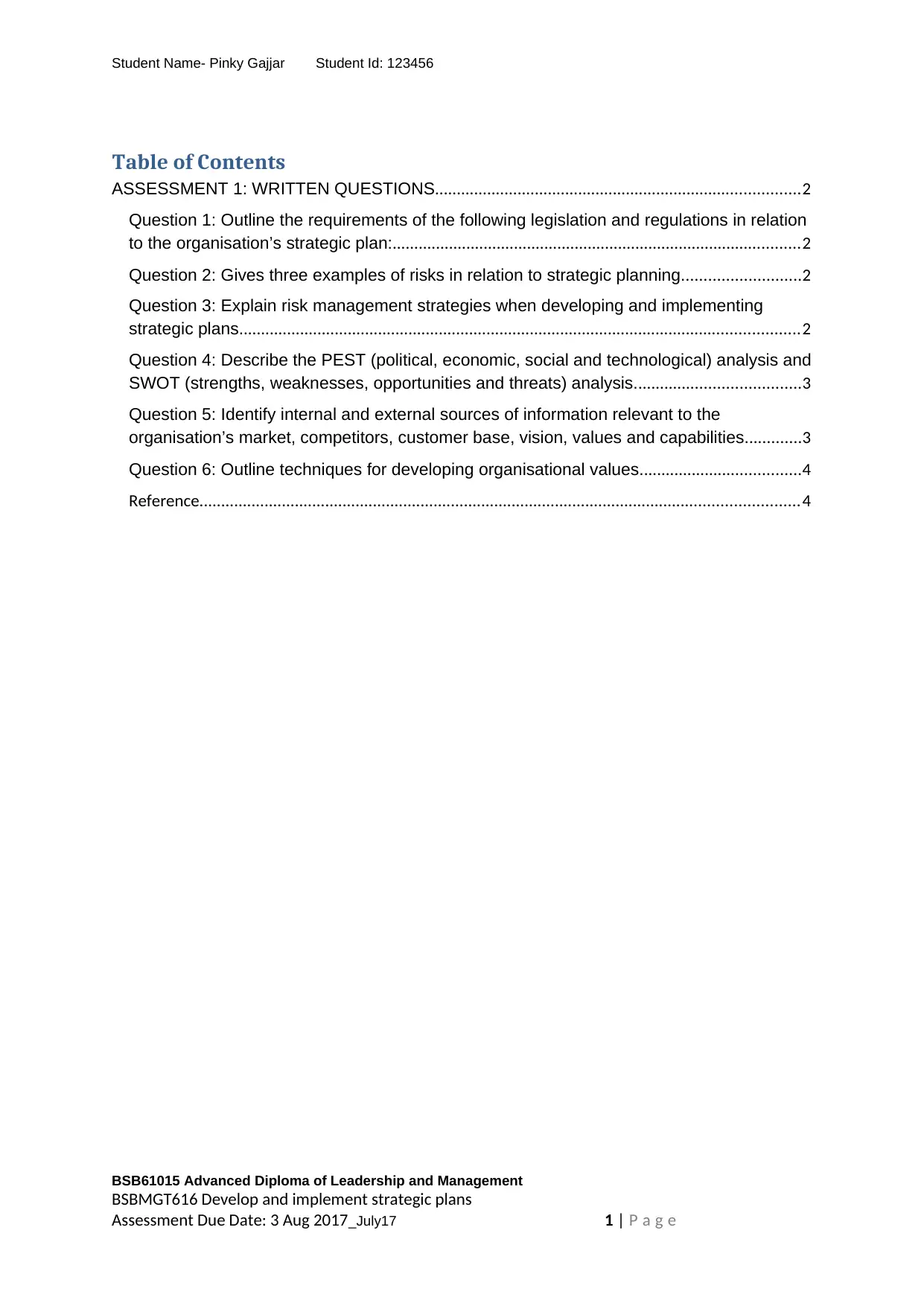
Student Name- Pinky Gajjar Student Id: 123456
Table of Contents
ASSESSMENT 1: WRITTEN QUESTIONS....................................................................................2
Question 1: Outline the requirements of the following legislation and regulations in relation
to the organisation’s strategic plan:..............................................................................................2
Question 2: Gives three examples of risks in relation to strategic planning...........................2
Question 3: Explain risk management strategies when developing and implementing
strategic plans.................................................................................................................................2
Question 4: Describe the PEST (political, economic, social and technological) analysis and
SWOT (strengths, weaknesses, opportunities and threats) analysis......................................3
Question 5: Identify internal and external sources of information relevant to the
organisation’s market, competitors, customer base, vision, values and capabilities.............3
Question 6: Outline techniques for developing organisational values.....................................4
Reference..........................................................................................................................................4
BSB61015 Advanced Diploma of Leadership and Management
BSBMGT616 Develop and implement strategic plans
Assessment Due Date: 3 Aug 2017_July17 1 | P a g e
Table of Contents
ASSESSMENT 1: WRITTEN QUESTIONS....................................................................................2
Question 1: Outline the requirements of the following legislation and regulations in relation
to the organisation’s strategic plan:..............................................................................................2
Question 2: Gives three examples of risks in relation to strategic planning...........................2
Question 3: Explain risk management strategies when developing and implementing
strategic plans.................................................................................................................................2
Question 4: Describe the PEST (political, economic, social and technological) analysis and
SWOT (strengths, weaknesses, opportunities and threats) analysis......................................3
Question 5: Identify internal and external sources of information relevant to the
organisation’s market, competitors, customer base, vision, values and capabilities.............3
Question 6: Outline techniques for developing organisational values.....................................4
Reference..........................................................................................................................................4
BSB61015 Advanced Diploma of Leadership and Management
BSBMGT616 Develop and implement strategic plans
Assessment Due Date: 3 Aug 2017_July17 1 | P a g e
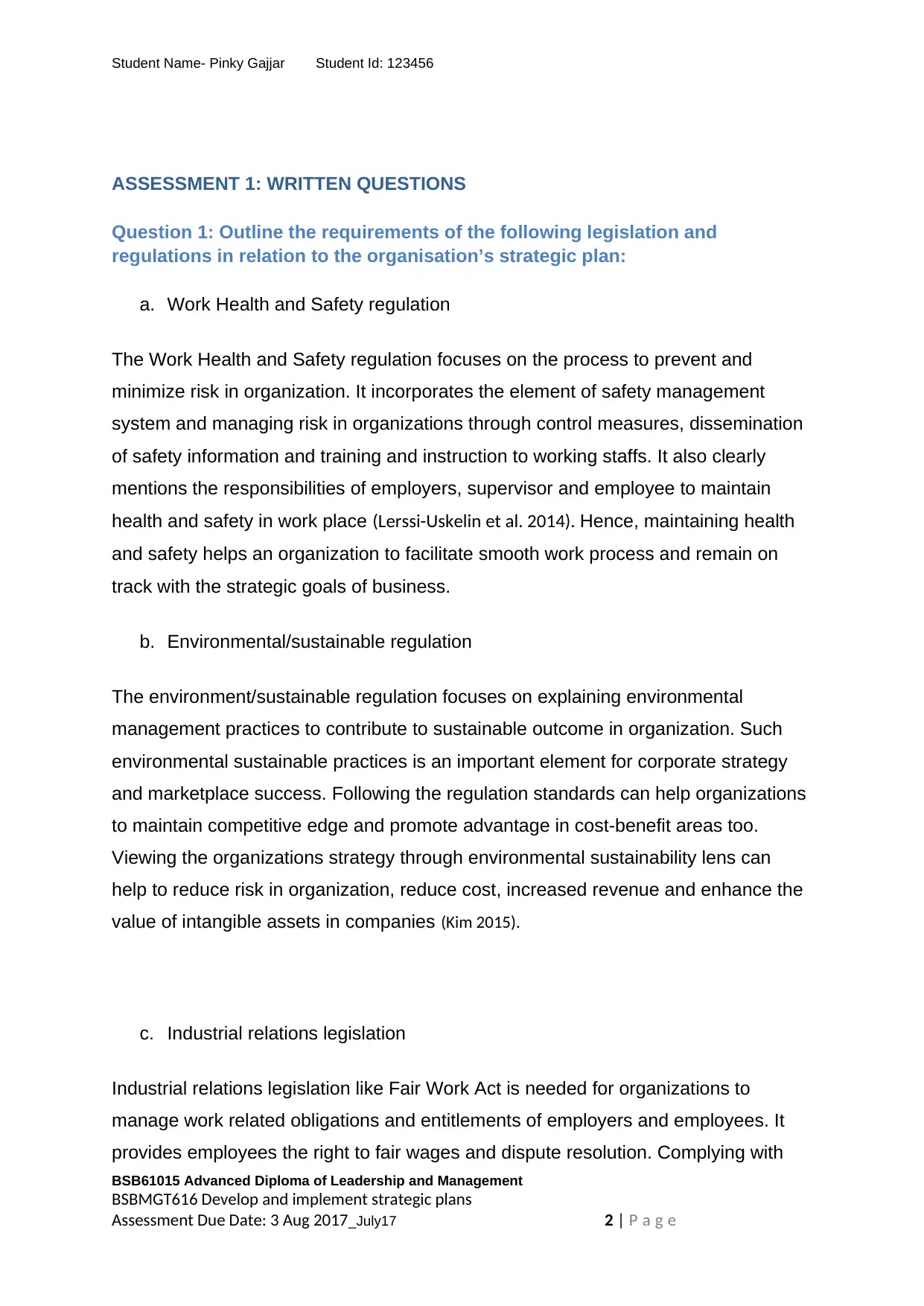
Student Name- Pinky Gajjar Student Id: 123456
ASSESSMENT 1: WRITTEN QUESTIONS
Question 1: Outline the requirements of the following legislation and
regulations in relation to the organisation’s strategic plan:
a. Work Health and Safety regulation
The Work Health and Safety regulation focuses on the process to prevent and
minimize risk in organization. It incorporates the element of safety management
system and managing risk in organizations through control measures, dissemination
of safety information and training and instruction to working staffs. It also clearly
mentions the responsibilities of employers, supervisor and employee to maintain
health and safety in work place (Lerssi-Uskelin et al. 2014). Hence, maintaining health
and safety helps an organization to facilitate smooth work process and remain on
track with the strategic goals of business.
b. Environmental/sustainable regulation
The environment/sustainable regulation focuses on explaining environmental
management practices to contribute to sustainable outcome in organization. Such
environmental sustainable practices is an important element for corporate strategy
and marketplace success. Following the regulation standards can help organizations
to maintain competitive edge and promote advantage in cost-benefit areas too.
Viewing the organizations strategy through environmental sustainability lens can
help to reduce risk in organization, reduce cost, increased revenue and enhance the
value of intangible assets in companies (Kim 2015).
c. Industrial relations legislation
Industrial relations legislation like Fair Work Act is needed for organizations to
manage work related obligations and entitlements of employers and employees. It
provides employees the right to fair wages and dispute resolution. Complying with
BSB61015 Advanced Diploma of Leadership and Management
BSBMGT616 Develop and implement strategic plans
Assessment Due Date: 3 Aug 2017_July17 2 | P a g e
ASSESSMENT 1: WRITTEN QUESTIONS
Question 1: Outline the requirements of the following legislation and
regulations in relation to the organisation’s strategic plan:
a. Work Health and Safety regulation
The Work Health and Safety regulation focuses on the process to prevent and
minimize risk in organization. It incorporates the element of safety management
system and managing risk in organizations through control measures, dissemination
of safety information and training and instruction to working staffs. It also clearly
mentions the responsibilities of employers, supervisor and employee to maintain
health and safety in work place (Lerssi-Uskelin et al. 2014). Hence, maintaining health
and safety helps an organization to facilitate smooth work process and remain on
track with the strategic goals of business.
b. Environmental/sustainable regulation
The environment/sustainable regulation focuses on explaining environmental
management practices to contribute to sustainable outcome in organization. Such
environmental sustainable practices is an important element for corporate strategy
and marketplace success. Following the regulation standards can help organizations
to maintain competitive edge and promote advantage in cost-benefit areas too.
Viewing the organizations strategy through environmental sustainability lens can
help to reduce risk in organization, reduce cost, increased revenue and enhance the
value of intangible assets in companies (Kim 2015).
c. Industrial relations legislation
Industrial relations legislation like Fair Work Act is needed for organizations to
manage work related obligations and entitlements of employers and employees. It
provides employees the right to fair wages and dispute resolution. Complying with
BSB61015 Advanced Diploma of Leadership and Management
BSBMGT616 Develop and implement strategic plans
Assessment Due Date: 3 Aug 2017_July17 2 | P a g e
⊘ This is a preview!⊘
Do you want full access?
Subscribe today to unlock all pages.

Trusted by 1+ million students worldwide
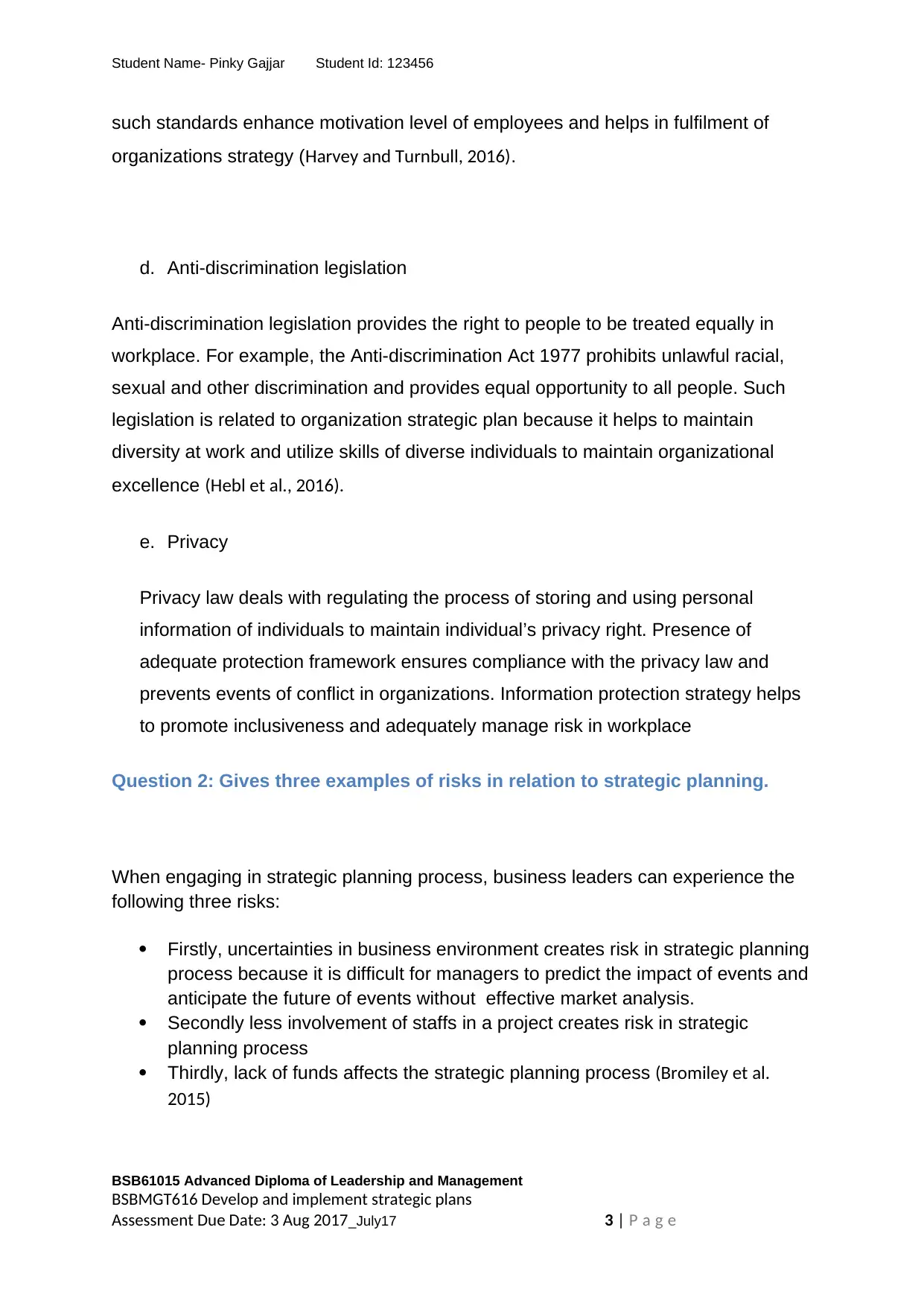
Student Name- Pinky Gajjar Student Id: 123456
such standards enhance motivation level of employees and helps in fulfilment of
organizations strategy (Harvey and Turnbull, 2016).
d. Anti-discrimination legislation
Anti-discrimination legislation provides the right to people to be treated equally in
workplace. For example, the Anti-discrimination Act 1977 prohibits unlawful racial,
sexual and other discrimination and provides equal opportunity to all people. Such
legislation is related to organization strategic plan because it helps to maintain
diversity at work and utilize skills of diverse individuals to maintain organizational
excellence (Hebl et al., 2016).
e. Privacy
Privacy law deals with regulating the process of storing and using personal
information of individuals to maintain individual’s privacy right. Presence of
adequate protection framework ensures compliance with the privacy law and
prevents events of conflict in organizations. Information protection strategy helps
to promote inclusiveness and adequately manage risk in workplace
Question 2: Gives three examples of risks in relation to strategic planning.
When engaging in strategic planning process, business leaders can experience the
following three risks:
Firstly, uncertainties in business environment creates risk in strategic planning
process because it is difficult for managers to predict the impact of events and
anticipate the future of events without effective market analysis.
Secondly less involvement of staffs in a project creates risk in strategic
planning process
Thirdly, lack of funds affects the strategic planning process (Bromiley et al.
2015)
BSB61015 Advanced Diploma of Leadership and Management
BSBMGT616 Develop and implement strategic plans
Assessment Due Date: 3 Aug 2017_July17 3 | P a g e
such standards enhance motivation level of employees and helps in fulfilment of
organizations strategy (Harvey and Turnbull, 2016).
d. Anti-discrimination legislation
Anti-discrimination legislation provides the right to people to be treated equally in
workplace. For example, the Anti-discrimination Act 1977 prohibits unlawful racial,
sexual and other discrimination and provides equal opportunity to all people. Such
legislation is related to organization strategic plan because it helps to maintain
diversity at work and utilize skills of diverse individuals to maintain organizational
excellence (Hebl et al., 2016).
e. Privacy
Privacy law deals with regulating the process of storing and using personal
information of individuals to maintain individual’s privacy right. Presence of
adequate protection framework ensures compliance with the privacy law and
prevents events of conflict in organizations. Information protection strategy helps
to promote inclusiveness and adequately manage risk in workplace
Question 2: Gives three examples of risks in relation to strategic planning.
When engaging in strategic planning process, business leaders can experience the
following three risks:
Firstly, uncertainties in business environment creates risk in strategic planning
process because it is difficult for managers to predict the impact of events and
anticipate the future of events without effective market analysis.
Secondly less involvement of staffs in a project creates risk in strategic
planning process
Thirdly, lack of funds affects the strategic planning process (Bromiley et al.
2015)
BSB61015 Advanced Diploma of Leadership and Management
BSBMGT616 Develop and implement strategic plans
Assessment Due Date: 3 Aug 2017_July17 3 | P a g e
Paraphrase This Document
Need a fresh take? Get an instant paraphrase of this document with our AI Paraphraser
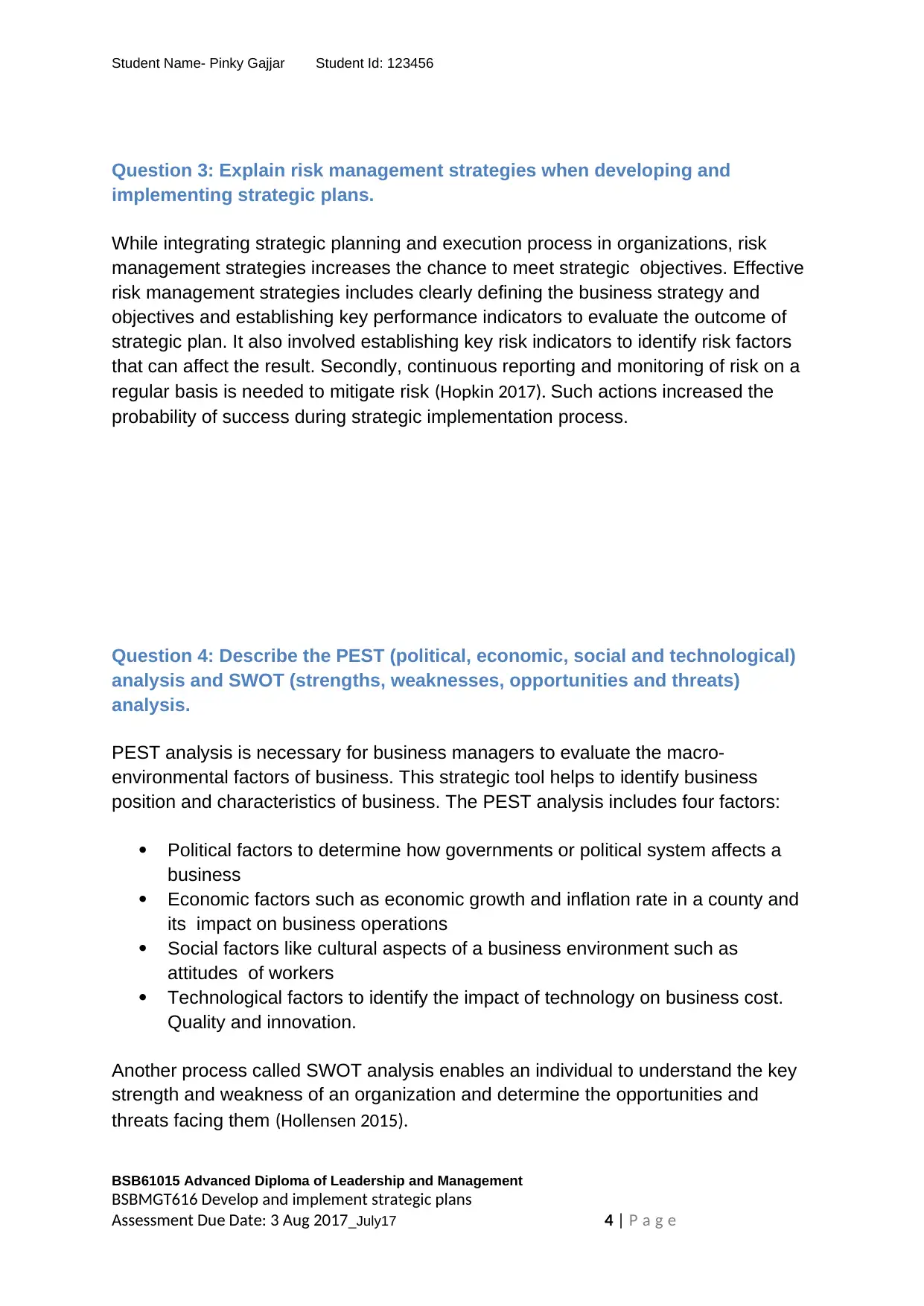
Student Name- Pinky Gajjar Student Id: 123456
Question 3: Explain risk management strategies when developing and
implementing strategic plans.
While integrating strategic planning and execution process in organizations, risk
management strategies increases the chance to meet strategic objectives. Effective
risk management strategies includes clearly defining the business strategy and
objectives and establishing key performance indicators to evaluate the outcome of
strategic plan. It also involved establishing key risk indicators to identify risk factors
that can affect the result. Secondly, continuous reporting and monitoring of risk on a
regular basis is needed to mitigate risk (Hopkin 2017). Such actions increased the
probability of success during strategic implementation process.
Question 4: Describe the PEST (political, economic, social and technological)
analysis and SWOT (strengths, weaknesses, opportunities and threats)
analysis.
PEST analysis is necessary for business managers to evaluate the macro-
environmental factors of business. This strategic tool helps to identify business
position and characteristics of business. The PEST analysis includes four factors:
Political factors to determine how governments or political system affects a
business
Economic factors such as economic growth and inflation rate in a county and
its impact on business operations
Social factors like cultural aspects of a business environment such as
attitudes of workers
Technological factors to identify the impact of technology on business cost.
Quality and innovation.
Another process called SWOT analysis enables an individual to understand the key
strength and weakness of an organization and determine the opportunities and
threats facing them (Hollensen 2015).
BSB61015 Advanced Diploma of Leadership and Management
BSBMGT616 Develop and implement strategic plans
Assessment Due Date: 3 Aug 2017_July17 4 | P a g e
Question 3: Explain risk management strategies when developing and
implementing strategic plans.
While integrating strategic planning and execution process in organizations, risk
management strategies increases the chance to meet strategic objectives. Effective
risk management strategies includes clearly defining the business strategy and
objectives and establishing key performance indicators to evaluate the outcome of
strategic plan. It also involved establishing key risk indicators to identify risk factors
that can affect the result. Secondly, continuous reporting and monitoring of risk on a
regular basis is needed to mitigate risk (Hopkin 2017). Such actions increased the
probability of success during strategic implementation process.
Question 4: Describe the PEST (political, economic, social and technological)
analysis and SWOT (strengths, weaknesses, opportunities and threats)
analysis.
PEST analysis is necessary for business managers to evaluate the macro-
environmental factors of business. This strategic tool helps to identify business
position and characteristics of business. The PEST analysis includes four factors:
Political factors to determine how governments or political system affects a
business
Economic factors such as economic growth and inflation rate in a county and
its impact on business operations
Social factors like cultural aspects of a business environment such as
attitudes of workers
Technological factors to identify the impact of technology on business cost.
Quality and innovation.
Another process called SWOT analysis enables an individual to understand the key
strength and weakness of an organization and determine the opportunities and
threats facing them (Hollensen 2015).
BSB61015 Advanced Diploma of Leadership and Management
BSBMGT616 Develop and implement strategic plans
Assessment Due Date: 3 Aug 2017_July17 4 | P a g e
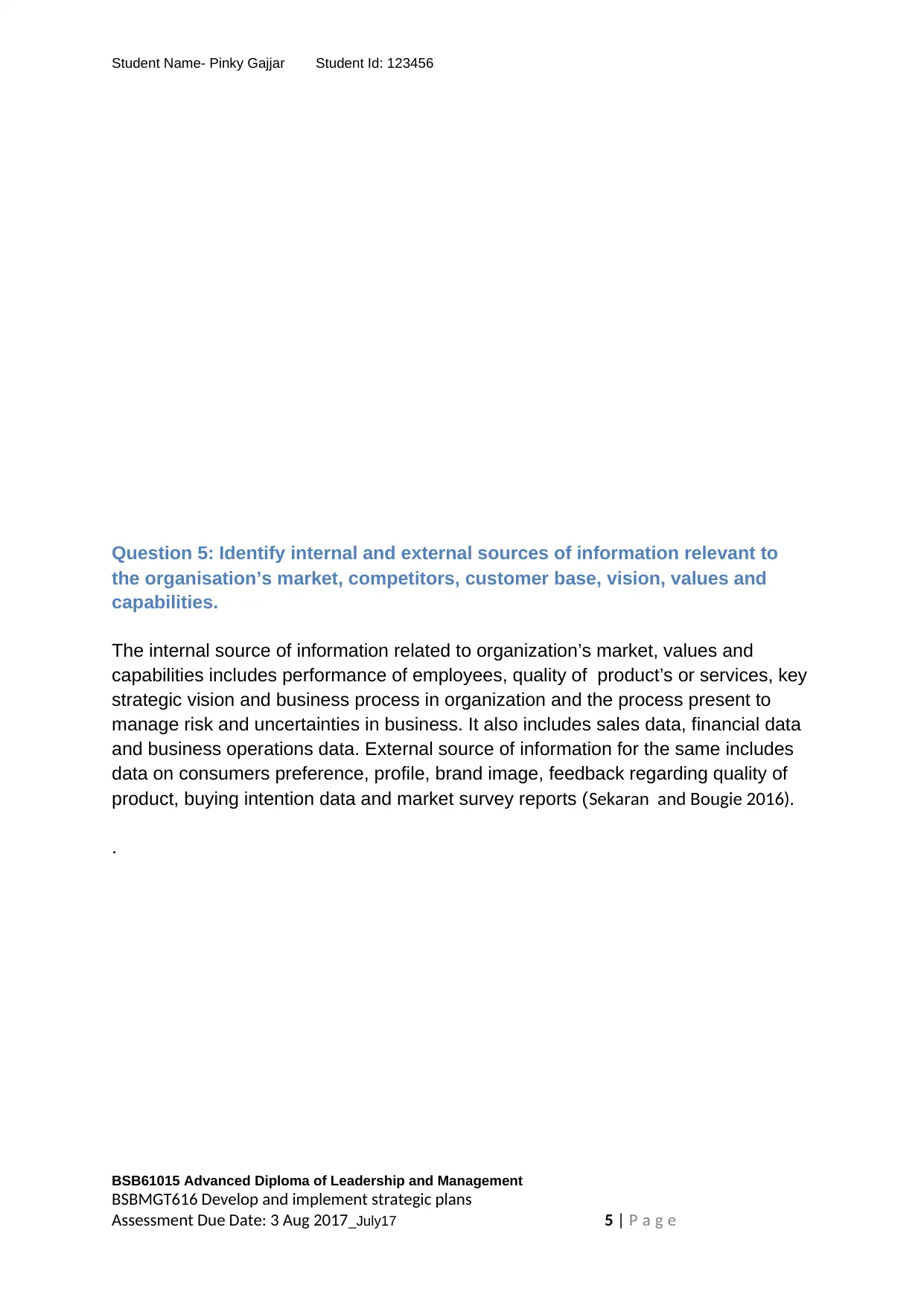
Student Name- Pinky Gajjar Student Id: 123456
Question 5: Identify internal and external sources of information relevant to
the organisation’s market, competitors, customer base, vision, values and
capabilities.
The internal source of information related to organization’s market, values and
capabilities includes performance of employees, quality of product’s or services, key
strategic vision and business process in organization and the process present to
manage risk and uncertainties in business. It also includes sales data, financial data
and business operations data. External source of information for the same includes
data on consumers preference, profile, brand image, feedback regarding quality of
product, buying intention data and market survey reports (Sekaran and Bougie 2016).
.
BSB61015 Advanced Diploma of Leadership and Management
BSBMGT616 Develop and implement strategic plans
Assessment Due Date: 3 Aug 2017_July17 5 | P a g e
Question 5: Identify internal and external sources of information relevant to
the organisation’s market, competitors, customer base, vision, values and
capabilities.
The internal source of information related to organization’s market, values and
capabilities includes performance of employees, quality of product’s or services, key
strategic vision and business process in organization and the process present to
manage risk and uncertainties in business. It also includes sales data, financial data
and business operations data. External source of information for the same includes
data on consumers preference, profile, brand image, feedback regarding quality of
product, buying intention data and market survey reports (Sekaran and Bougie 2016).
.
BSB61015 Advanced Diploma of Leadership and Management
BSBMGT616 Develop and implement strategic plans
Assessment Due Date: 3 Aug 2017_July17 5 | P a g e
⊘ This is a preview!⊘
Do you want full access?
Subscribe today to unlock all pages.

Trusted by 1+ million students worldwide
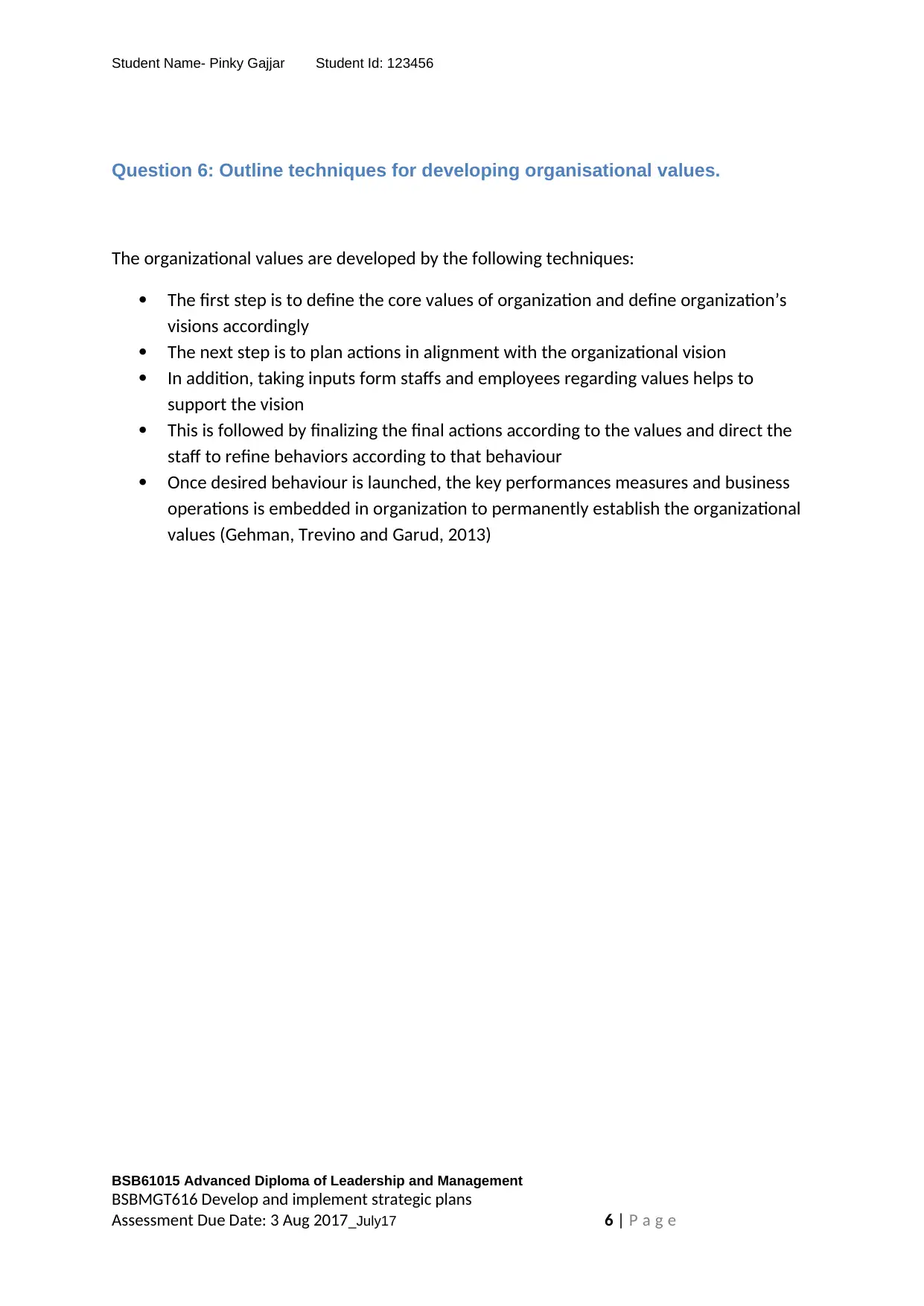
Student Name- Pinky Gajjar Student Id: 123456
Question 6: Outline techniques for developing organisational values.
The organizational values are developed by the following techniques:
The first step is to define the core values of organization and define organization’s
visions accordingly
The next step is to plan actions in alignment with the organizational vision
In addition, taking inputs form staffs and employees regarding values helps to
support the vision
This is followed by finalizing the final actions according to the values and direct the
staff to refine behaviors according to that behaviour
Once desired behaviour is launched, the key performances measures and business
operations is embedded in organization to permanently establish the organizational
values (Gehman, Trevino and Garud, 2013)
BSB61015 Advanced Diploma of Leadership and Management
BSBMGT616 Develop and implement strategic plans
Assessment Due Date: 3 Aug 2017_July17 6 | P a g e
Question 6: Outline techniques for developing organisational values.
The organizational values are developed by the following techniques:
The first step is to define the core values of organization and define organization’s
visions accordingly
The next step is to plan actions in alignment with the organizational vision
In addition, taking inputs form staffs and employees regarding values helps to
support the vision
This is followed by finalizing the final actions according to the values and direct the
staff to refine behaviors according to that behaviour
Once desired behaviour is launched, the key performances measures and business
operations is embedded in organization to permanently establish the organizational
values (Gehman, Trevino and Garud, 2013)
BSB61015 Advanced Diploma of Leadership and Management
BSBMGT616 Develop and implement strategic plans
Assessment Due Date: 3 Aug 2017_July17 6 | P a g e
Paraphrase This Document
Need a fresh take? Get an instant paraphrase of this document with our AI Paraphraser
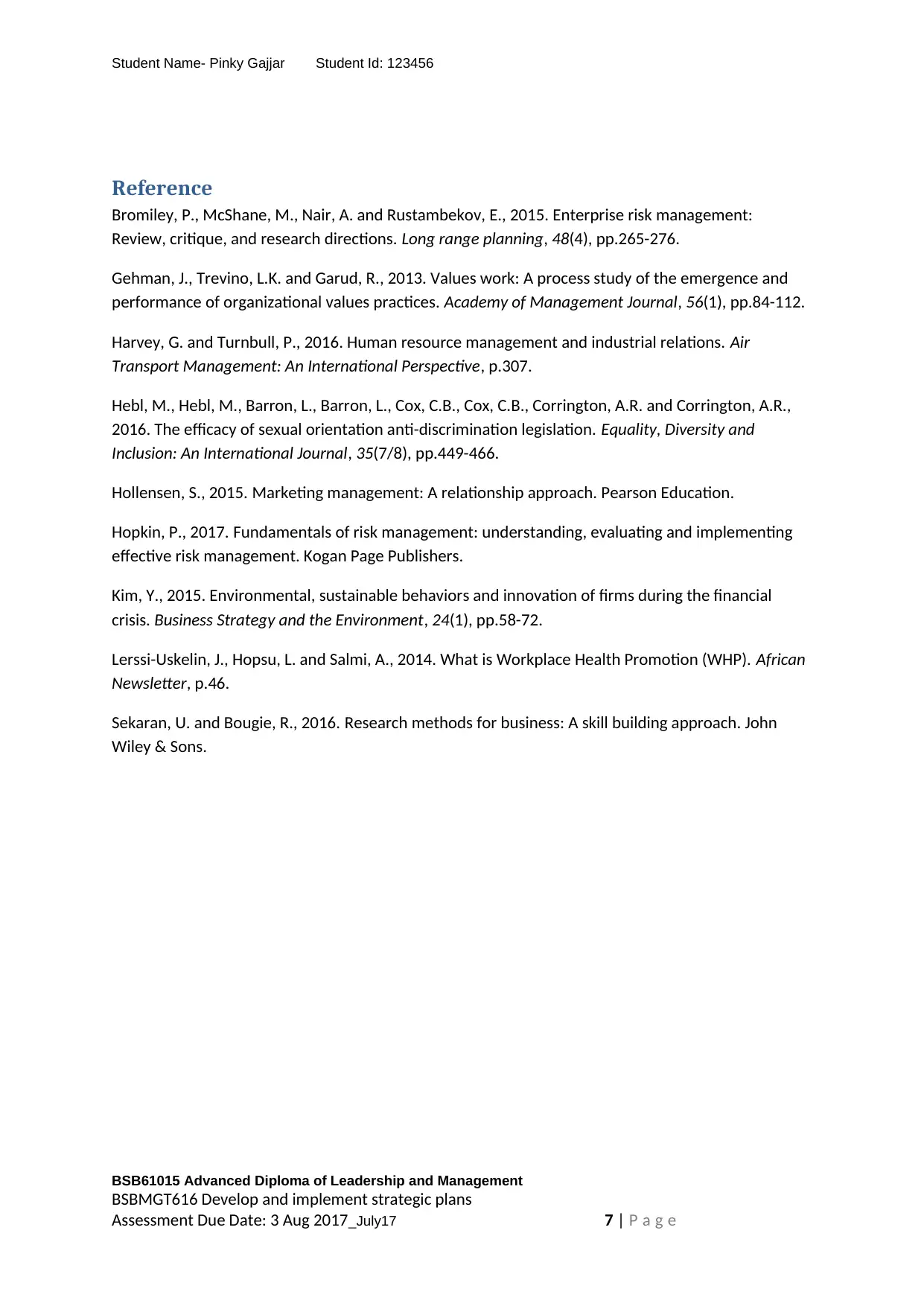
Student Name- Pinky Gajjar Student Id: 123456
Reference
Bromiley, P., McShane, M., Nair, A. and Rustambekov, E., 2015. Enterprise risk management:
Review, critique, and research directions. Long range planning, 48(4), pp.265-276.
Gehman, J., Trevino, L.K. and Garud, R., 2013. Values work: A process study of the emergence and
performance of organizational values practices. Academy of Management Journal, 56(1), pp.84-112.
Harvey, G. and Turnbull, P., 2016. Human resource management and industrial relations. Air
Transport Management: An International Perspective, p.307.
Hebl, M., Hebl, M., Barron, L., Barron, L., Cox, C.B., Cox, C.B., Corrington, A.R. and Corrington, A.R.,
2016. The efficacy of sexual orientation anti-discrimination legislation. Equality, Diversity and
Inclusion: An International Journal, 35(7/8), pp.449-466.
Hollensen, S., 2015. Marketing management: A relationship approach. Pearson Education.
Hopkin, P., 2017. Fundamentals of risk management: understanding, evaluating and implementing
effective risk management. Kogan Page Publishers.
Kim, Y., 2015. Environmental, sustainable behaviors and innovation of firms during the financial
crisis. Business Strategy and the Environment, 24(1), pp.58-72.
Lerssi-Uskelin, J., Hopsu, L. and Salmi, A., 2014. What is Workplace Health Promotion (WHP). African
Newsletter, p.46.
Sekaran, U. and Bougie, R., 2016. Research methods for business: A skill building approach. John
Wiley & Sons.
BSB61015 Advanced Diploma of Leadership and Management
BSBMGT616 Develop and implement strategic plans
Assessment Due Date: 3 Aug 2017_July17 7 | P a g e
Reference
Bromiley, P., McShane, M., Nair, A. and Rustambekov, E., 2015. Enterprise risk management:
Review, critique, and research directions. Long range planning, 48(4), pp.265-276.
Gehman, J., Trevino, L.K. and Garud, R., 2013. Values work: A process study of the emergence and
performance of organizational values practices. Academy of Management Journal, 56(1), pp.84-112.
Harvey, G. and Turnbull, P., 2016. Human resource management and industrial relations. Air
Transport Management: An International Perspective, p.307.
Hebl, M., Hebl, M., Barron, L., Barron, L., Cox, C.B., Cox, C.B., Corrington, A.R. and Corrington, A.R.,
2016. The efficacy of sexual orientation anti-discrimination legislation. Equality, Diversity and
Inclusion: An International Journal, 35(7/8), pp.449-466.
Hollensen, S., 2015. Marketing management: A relationship approach. Pearson Education.
Hopkin, P., 2017. Fundamentals of risk management: understanding, evaluating and implementing
effective risk management. Kogan Page Publishers.
Kim, Y., 2015. Environmental, sustainable behaviors and innovation of firms during the financial
crisis. Business Strategy and the Environment, 24(1), pp.58-72.
Lerssi-Uskelin, J., Hopsu, L. and Salmi, A., 2014. What is Workplace Health Promotion (WHP). African
Newsletter, p.46.
Sekaran, U. and Bougie, R., 2016. Research methods for business: A skill building approach. John
Wiley & Sons.
BSB61015 Advanced Diploma of Leadership and Management
BSBMGT616 Develop and implement strategic plans
Assessment Due Date: 3 Aug 2017_July17 7 | P a g e
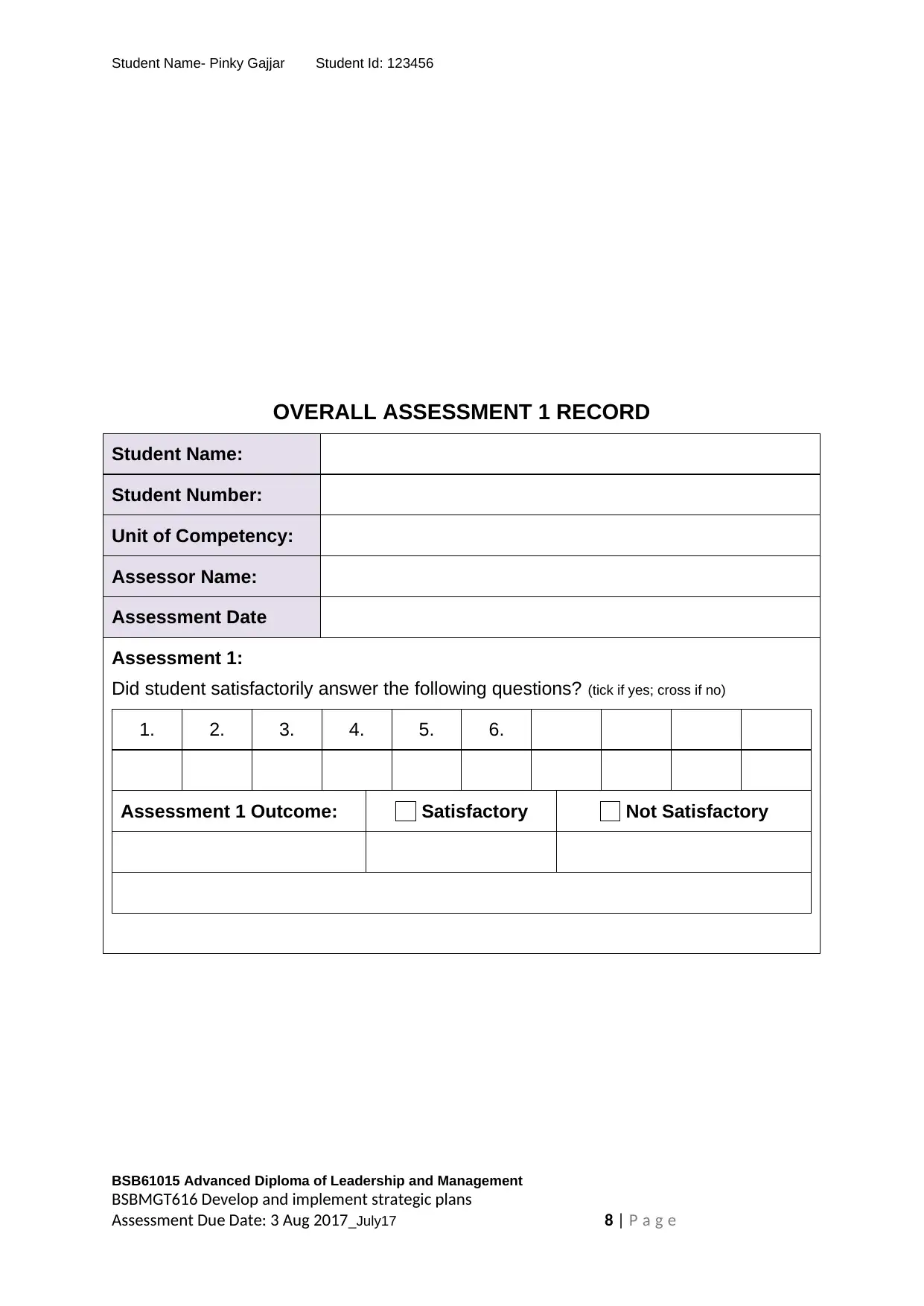
Student Name- Pinky Gajjar Student Id: 123456
OVERALL ASSESSMENT 1 RECORD
Student Name:
Student Number:
Unit of Competency:
Assessor Name:
Assessment Date
Assessment 1:
Did student satisfactorily answer the following questions? (tick if yes; cross if no)
1. 2. 3. 4. 5. 6.
Assessment 1 Outcome: Satisfactory Not Satisfactory
BSB61015 Advanced Diploma of Leadership and Management
BSBMGT616 Develop and implement strategic plans
Assessment Due Date: 3 Aug 2017_July17 8 | P a g e
OVERALL ASSESSMENT 1 RECORD
Student Name:
Student Number:
Unit of Competency:
Assessor Name:
Assessment Date
Assessment 1:
Did student satisfactorily answer the following questions? (tick if yes; cross if no)
1. 2. 3. 4. 5. 6.
Assessment 1 Outcome: Satisfactory Not Satisfactory
BSB61015 Advanced Diploma of Leadership and Management
BSBMGT616 Develop and implement strategic plans
Assessment Due Date: 3 Aug 2017_July17 8 | P a g e
⊘ This is a preview!⊘
Do you want full access?
Subscribe today to unlock all pages.

Trusted by 1+ million students worldwide
1 out of 9
Related Documents
Your All-in-One AI-Powered Toolkit for Academic Success.
+13062052269
info@desklib.com
Available 24*7 on WhatsApp / Email
![[object Object]](/_next/static/media/star-bottom.7253800d.svg)
Unlock your academic potential
Copyright © 2020–2025 A2Z Services. All Rights Reserved. Developed and managed by ZUCOL.


